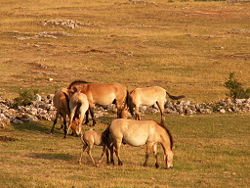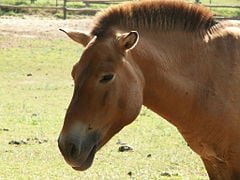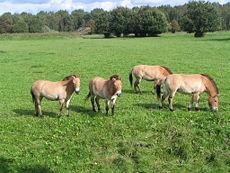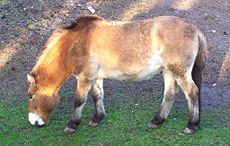Difference between revisions of "Przewalski's horse" - New World Encyclopedia
Rick Swarts (talk | contribs) |
Rosie Tanabe (talk | contribs) |
||
| (19 intermediate revisions by 3 users not shown) | |||
| Line 1: | Line 1: | ||
| + | {{Images OK}}{{Approved}}{{Copyedited}} | ||
{{Taxobox | {{Taxobox | ||
| name = Przewalski's horse | | name = Przewalski's horse | ||
| Line 18: | Line 19: | ||
| trinomial_authority = ([[Poliakov]], 1881) | | trinomial_authority = ([[Poliakov]], 1881) | ||
}} | }} | ||
| − | + | '''Przewalski's horse''' is a rare, wild horse of [[Asia]], ''Equus ferus przewalskii'', characterized by a stocky built, a dark brown mane and tail, pale brown or dun-colored flanks, and often faintly striped legs. This large [[ungulate]] [[mammal]] is the last remaining wild horse ''(Equus ferus)'', although some classify it as another species, ''Equus przewalskii'', or as a domestic horse subspecies, ''Equus caballus przewalskii''. Przewalski's horse is the closest living wild relative of the domestic [[horse]] ''(Equus caballus)'', and it and the domestic horse are the only equids (genus ''Equus'' or family Equidae) that can crossbreed and produce fertile offspring, although they have different numbers of [[chromosome]]s. Przewalski's horse also is known as the '''Asian wild horse''', '''Mongolian wild horse''', or '''takhi'''. | |
| − | '''Przewalski's horse''' is a rare, wild horse of [[Asia]], ''Equus ferus przewalskii'', characterized by a stocky built, a dark brown mane and tail, pale brown or dun-colored flanks, and often faintly striped legs. This large [[ungulate]] [[mammal]] is the last remaining wild horse | ||
Most "wild" horses today, such as the [[United States|American]] [[Mustang (horse)|mustang]] or the [[Australia]]n [[brumby]], are actually [[feral]] animals, horses that were once [[domesticated]] but escaped and reverted to an apparently wild status. Przewalski's horse, on the other hand, has never been successfully domesticated and remains a truly wild animal today. The tarpan, ''Equus ferus ferus'', was also a wild horse, but became extinct in the early twentieth century. | Most "wild" horses today, such as the [[United States|American]] [[Mustang (horse)|mustang]] or the [[Australia]]n [[brumby]], are actually [[feral]] animals, horses that were once [[domesticated]] but escaped and reverted to an apparently wild status. Przewalski's horse, on the other hand, has never been successfully domesticated and remains a truly wild animal today. The tarpan, ''Equus ferus ferus'', was also a wild horse, but became extinct in the early twentieth century. | ||
| − | At one point, Przewalski's horse was [[extinction|extinct]] in the wild, but in the 1990s was reintroduced into the | + | At one point, Przewalski's horse was [[extinction|extinct]] in the wild, but in the 1990s was reintroduced into the [[Mongolia]]n [[steppe]] from [[zoo]]s and is now considered [[endangered species|endangered]] in the wild. As a result of its preservation and reintroduction, this unique animal will be able to be appreciated and studied by future generations. |
==Overview and description== | ==Overview and description== | ||
| Line 29: | Line 29: | ||
Przewalski's horse is one of ten living members of the ''Equus'' genus, a [[taxon]] that also includes [[horse|domestic horses]], [[zebra]]s, [[donkey]]s, and [[onager]]s. All of the living members of the Equidae family are in the ''Equus'' genus. Extant equids are medium to large [[ungulate]] [[mammal]]s, with long heads, and necks with a [[mane (horse)|mane]]. Their legs are slender and end in a single, [[unguligrade]] toe, protected by a horny [[horse hoof|hoof]]. They have long, slender, tails, either ending in a tuft, or entirely covered in flowing hair. The [[pinna (anatomy)|pinnae]] ("ears") of equids are mobile, enabling them to easily localize the origin of sounds. They have two-color, or [[Dichromacy|dichromatic vision]]. Their eyes are set back far on the head, giving them a wide angle of view, without entirely losing [[binocular vision]]. Equids also have a [[vomeronasal organ]], that allows males to use the [[flehmen]], or "lip-curling" response to assess the sexual state of potential mates. | Przewalski's horse is one of ten living members of the ''Equus'' genus, a [[taxon]] that also includes [[horse|domestic horses]], [[zebra]]s, [[donkey]]s, and [[onager]]s. All of the living members of the Equidae family are in the ''Equus'' genus. Extant equids are medium to large [[ungulate]] [[mammal]]s, with long heads, and necks with a [[mane (horse)|mane]]. Their legs are slender and end in a single, [[unguligrade]] toe, protected by a horny [[horse hoof|hoof]]. They have long, slender, tails, either ending in a tuft, or entirely covered in flowing hair. The [[pinna (anatomy)|pinnae]] ("ears") of equids are mobile, enabling them to easily localize the origin of sounds. They have two-color, or [[Dichromacy|dichromatic vision]]. Their eyes are set back far on the head, giving them a wide angle of view, without entirely losing [[binocular vision]]. Equids also have a [[vomeronasal organ]], that allows males to use the [[flehmen]], or "lip-curling" response to assess the sexual state of potential mates. | ||
| − | Equids are [[herbivore]]s, and feed predominantly on tough, fibrous food, such as [[grass]]es and sedges. When in need, they will also eat other vegetable matter, such as leaves, | + | Equids are [[herbivore]]s, and feed predominantly on tough, fibrous food, such as [[grass]]es and sedges. When in need, they will also eat other [[vegetable]] matter, such as [[leaf|leaves]], [[fruit]]s, or bark, but are normally [[grazer]]s, not browsers. Unlike [[ruminant]]s, with their complex stomachs, equids break down [[cellulose]] in the "hindgut" or [[cecum]], a part of the [[colon]]. |
===Przewalski's horse=== | ===Przewalski's horse=== | ||
| + | [[Image:Unsortedanimal 1.jpg|thumb|240px|[[Przewalski's horse]]s. The animal on the left shows the dorsal stripe along its spine, the one on the right shows faint horizontal "zebra" striping on the back of its legs by the knee (click image to enlarge), both classic examples of "primitive" dun markings]] | ||
| + | Przewalski's horse is placed into the same subgenus, ''Equus'', as the [[horse|domestic horse]] ''(Equus caballus)'', the wild horse ''(Equus ferus)'', the tarpan (''Equus ferus ferus'', a subspecies of the wild horse), and the Yukon horse ''(Equus lambei)''. The taxonomy of the Przewalski's horse, however, remains debated. Poliakov concluded that the animal was a wild horse species and gave it the official name ''Equus przewalskii'' (Poliakov 1881). Some consider it the last remnant of the wild horse, ''Equus ferus'', and list it as the subspecies ''Equus ferus przewalskii''. Others hold it as a subspecies of ''Equus caballus'' (domestic horse) as ''Equus caballus przewalskii''). | ||
| − | + | Although Przewalski's horse has 66 [[chromosome]]s, compared to 64 in a domestic horse, the Przewalski's horse and the domestic horse are the only [[equid]]s that crossbreed and produce fertile offspring, with the offspring possessing 65 chromosomes (Bell 2004). Normally, the offspring of a domestic horse and another equid, such as a [[zebra]] or a [[donkey]], are sterile. However, the offspring of Przewalski horses and domestic horses are not sterile and subsequent crossings can lead back to either species. Bell (2004) notes that "if the offspring is crossed back to a domestic horse, the resulting animal will have 64 chromosomes and very few Przewalski characteristics." | |
| − | |||
| − | Although | ||
Przewalski's horse is stockily built in comparison to domesticated horses, with shorter legs. It has a large head. Typical height is about 13 [[hand (unit)|hands]] (1.32 meters), length is about 2.1 meters with a 90 centimeter tail. They weigh between 550 and 750 pounds (250 to 340 kilograms). The coat ranges from brown to the [[Dun (color)|dun]] coloration (sandy yellow to reddish-brown) of domestic horses. It is dark brown around the mane (which stands erect) and yellowish-white on the belly. There is a dark stripe down the middle of the back and the legs are often faintly striped (NZP). | Przewalski's horse is stockily built in comparison to domesticated horses, with shorter legs. It has a large head. Typical height is about 13 [[hand (unit)|hands]] (1.32 meters), length is about 2.1 meters with a 90 centimeter tail. They weigh between 550 and 750 pounds (250 to 340 kilograms). The coat ranges from brown to the [[Dun (color)|dun]] coloration (sandy yellow to reddish-brown) of domestic horses. It is dark brown around the mane (which stands erect) and yellowish-white on the belly. There is a dark stripe down the middle of the back and the legs are often faintly striped (NZP). | ||
==Behavior== | ==Behavior== | ||
| − | [[Image:Equus przewalskii Le Villaret 02 2006-07-20.jpg|thumb|left|250px|Przewalski's | + | [[Image:Equus przewalskii Le Villaret 02 2006-07-20.jpg|thumb|left|250px|Przewalski's horses]] |
| − | + | In the wild, Przewalski's horses live in social groups consisting of a dominant stallion, a dominant lead mare, other mares, and their offspring. The patterns of their daily lives exhibit [[horse behavior]] similar to that of [[feral horse]] herds: Each group has a well-defined home range; within the range, the herd travels between three and six miles a day, spending time grazing, drinking, using [[salt]] licks, and dozing. At night, the herd clusters and sleeps for about four hours. Ranges of different herds may overlap without conflict, as the stallions are more protective of their mares than their territory. | |
| − | In the wild, Przewalski's | ||
| − | Stallions practice a form of [[scent marking]] and will establish piles of dung at intervals along routes they normally travel to warn other males of their presence. | + | Stallions practice a form of [[scent marking]] and will establish piles of dung at intervals along routes they normally travel to warn other males of their presence. In addition, when a female in the herd urinates, the stallion will frequently urinate in the same place, to signal her membership in the herd to other males. The stallions can frequently be seen sniffing dung piles to confirm scent markings (King and Gurnell 2006). |
| + | == History == | ||
| + | In the fifteenth century, [[Johann Schiltberger]] recorded one of the first European sightings of the horses in the journal of his trip to Mongolia as a prisoner of the [[Mongol]] [[Khan (title)|Khan]] (DAS 1998). The horse is named after Russian General [[Nikolai Przhevalsky]] (1839–1888) (the spelling of the horse breed as "Przewalski" derives from the [[Polish language|Polish]] spelling of the name). He was an explorer and naturalist who described the horse in 1881, after having gone on an expedition to find it, based on rumors of its existence. Many of these horses were captured around 1900 by [[Carl Hagenbeck]] and placed in [[zoo]]s. | ||
| − | + | [[Image:Equus przewalskii Parc du Thot 01 2006-07-18.jpg|thumb|240px|left|Przewalski's horse at the Parc du Thot, France]] | |
| − | + | The native population declined in the 20th century due to a combination of factors, with the wild population in [[Mongolia]] dying out in the 1960s. The last herd was sighted in 1967 and the last individual horse in 1969. Expeditions after this failed to locate any horses, and the species was designated "extinct in the wild" for over 30 years. | |
| + | After 1945, only two captive populations in zoos remained: in [[Munich]] and in [[Prague Zoo]]. The most valuable group in [[Askania Nova]] reserve in the [[Ukraine]] was shot down by [[Germany|German]] soldiers during occupation and the group in the [[United States]] had died. | ||
| + | [[Image:Prezewalsky 26-9-2004-3.JPG|thumb|230px|right|Przewalski's horses]] | ||
| + | In 1977, the Foundation for the Preservation and Protection of the Przewalski Horse was founded by Jan and [[Inge Bouman]], which started a program of exchange between captive populations in zoos throughout the world to reduce [[inbreeding]], and later starting a breeding program of its own. | ||
| − | + | In 1992, a cooperative venture between the Zoological Society of London and Mongolian scientists resulted in successful reintroduction of these horses from [[zoo]]s into their natural habitat in [[Mongolia]]. Sixteen horses first were released into the wild in Mongolia, followed by additional animals later on. These reintroduced horses successfully reproduced and the status of the animal was considered to have changed from "extinct in the wild" to "endangered" in 2005 (ZSL 2006). However, they are classified as "extinct in the wild" by the [[IUCN Red List]], as they have not been reassessed since 1996 (ESG 1996). The area to which they were reintroduced became [[Khustain Nuruu National Park]] in 1998. | |
| − | In | ||
| − | |||
| − | The | ||
| − | + | ==Population size and reservation efforts== | |
| − | + | As of a census taken in 2005, the world population of Przewalski's horses was about 1,500, all descended from 31 horses that were in captivity in 1945, mostly descended from approximately 15 captured around 1900. As of 2005, there is a free-ranging population of 248 animals in the wild (ZSL 2006). | |
| − | |||
| − | |||
While dozens of zoos worldwide have Przewalski's Horses in small numbers, there are also specialized reserves dedicated primarily to the species. | While dozens of zoos worldwide have Przewalski's Horses in small numbers, there are also specialized reserves dedicated primarily to the species. | ||
| − | The world's largest captive breeding program for Przewalski's horses is at the [[Askania Nova]] preserve in Ukraine. Several dozen Przewalski's horses were also released in the area evacuated after the [[Chernobyl accident]], which now serves as a deserted [[de facto]] natural preserve | + | The world's largest captive breeding program for Przewalski's horses is at the [[Askania Nova]] preserve in [[Ukraine]]. Several dozen Przewalski's horses were also released in the area evacuated after the [[Chernobyl accident]], which now serves as a deserted [[de facto]] natural preserve (Mulvey 2006). An intensely researched population of free-ranging animals was introduced to the [[Hortobágy]] [[puszta]] in [[Hungary]]; data on social structure, behavior, and diseases gathered from these animals is used to improve the Mongolian conservation effort. |
| − | [[Image:Przewalski's Horse, Dubbo Zoo, c 2005.jpg|thumb|230px|right|Przewalski's | + | [[Image:Przewalski's Horse, Dubbo Zoo, c 2005.jpg|thumb|230px|right|Przewalski's horse, Dubbo Zoo, Aust.]] |
| − | Three animals from this program live in a 12 acre (5 hectare) paddock in the [[Clocaenog Forest]] in [[North Wales]], [[United Kingdom|UK]], on the site of a former [[Neolithic]] or [[British Iron Age|Iron Age]] settlement. They were introduced there in 2004. The [[Forestry Commission]] hopes they will help recreate scenes from the Iron Age when horses similar to these roamed Britain freely | + | Three animals from this program live in a 12 acre (5 hectare) paddock in the [[Clocaenog Forest]] in [[North Wales]], [[United Kingdom|UK]], on the site of a former [[Neolithic]] or [[British Iron Age|Iron Age]] settlement. They were introduced there in 2004. The [[Forestry Commission]] hopes they will help recreate scenes from the Iron Age when horses similar to these roamed Britain freely, with Przewalski's horse believed to have roamed Britain three to 4,000 years ago, as evidenced from cave paintings (FC 2004). |
| − | |||
| − | Another herd exists at The Wilds Wildlife Preserve in [[Cumberland, Ohio]], [[USA]]. The small herd of about 17 individuals is kept in a large area shared with other Asian animals. | + | Another herd exists at The Wilds Wildlife Preserve in [[Cumberland, Ohio]], [[USA]]. The small herd of about 17 individuals is kept in a large area shared with other Asian animals. A small population is also kept by the [[Smithsonian Institution]] at a facility near [[Front Royal]], Virginia and in the [[Smithsonian National Zoological Park]] in Washington, DC. |
| − | Recent advances in equine reproductive science have potential to further preserve and expand the gene pool. | + | Recent advances in equine reproductive science have potential to further preserve and expand the gene pool. In October, 2007 scientists at the Smithsonian Institution's National Zoo successfully reversed a [[vasectomy]] on a Przewalski horse—the first operation of its kind on this species and possibly the first ever on any endangered species. While normally a vasectomy may be performed on an endangered animal under limited circumstances, particularly if an individual has already produced many offspring and its genes are overrepresented in the population, scientists realized the animal in question was one of the most genetically valuable Przewalski horses in the North American breeding program (AP 2008). |
==References== | ==References== | ||
| − | + | * Associated Press (AP). 2008. [http://www.thehorse.com/ViewArticle.aspx?ID=12095 Zoo performs first reverse vasectomy on horse]. ''The Horse'' June 17, 2008 (article # 12095). Retrieved August 17, 2008. | |
| − | ( | + | |
| + | * Bell, B. 2004. [http://www.equinepost.com/resources/articles.asp?ID=2 Featured equine: The Przewalski horse]. ''EquinePost.com''. Retrieved August 17, 2008. | ||
| + | |||
| + | * Department of Animal Science (DAS), Oklahoma State University. 1998. [http://www.ansi.okstate.edu/breeds/horses/przewalski/index.htm Breeds of livestock: Przewalski (sha-val-ski)]. ''Oklahoma State University''. Retrieved August 17, 2008. | ||
| + | |||
| + | * Equid Specialist Group (ESG). 1996. [http://www.redlist.org/search/details.php?species=7961 ''Equus ferus ssp. przewalskii'']. ''2007 IUCN Red List of Threatened Species''. Retrieved August 17, 2008. | ||
| + | |||
| + | * Forestry Commission (FC). 2004. FC Wales turns clock back thousands of years with "wild" solution to looking after ancient forest site. ''Forestry Commission, Great Britain'' New Release 7001, September 16, 2004. | ||
| + | |||
| + | * International Commission on Zoological Nomenclature (ICZN). 2003. Opinion 2027 (Case 3010). Usage of 17 specific names based on wild species which are pre-dated by or contemporary with those based on domestic animals (Lepidoptera, Osteichthyes, Mammalia): Conserved. ''Bull.Zool.Nomencl.'' 60: 81-84. | ||
| + | |||
| + | * Ishida, N., T. Oyunsuren, S. Mashima, et al. 1995. [http://www.springerlink.com/content/t056l16v527161t0/ Mitochondrial DNA sequences of various species of the genus ''Equus'' with special reference to the phylogenetic relationship between Przewalskii's wild horse and domestic horse]. ''Journal of Molecular Evolution'' 41(2): 180–188. Retrieved August 17, 2008. | ||
| + | |||
| + | * Jansen, T., P. Forster, M. A. Levine, et al. 2002. [http://www.ncbi.nlm.nih.gov/pubmed/12130666 Mitochondrial DNA and the origins of the domestic horse]. ''PNAS'' 99(16): 10905–10910. PMID 12130666. Retrieved August 17, 2008. | ||
| − | by | + | * King, S. R. B., and J. Gurnell. 2006. [http://www3.interscience.wiley.com/journal/118535480/abstract?CRETRY=1&SRETRY=0 Scent-marking behavior by stallions: An assessment of function in a reintroduced population of Przewalski horses, ''(Equus ferus przewalskii)'']. ''Journal of Zoology'' 272(1): 30–36. Retrieved August 17, 2008. |
| − | http:// | + | * Mulvey, S. 2006. [http://news.bbc.co.uk/2/hi/europe/4923342.stm Wildlife defies Chernobyl radiation]. ''BBC News'' April 20, 2006. Retrieved August 17, 2008. |
| − | |||
| − | |||
| − | |||
| − | + | * National Zoological Park (NZP). n.d. [http://nationalzoo.si.edu/Animals/AsiaTrail/fact-phorse.cfm Przewalski's Horse, ''Equus ferus przewalskii'']. ''National Zoological Park''. Retrieved August 17, 2008. | |
| − | Equus ferus przewalskii | ||
| + | * Wakefield, S., J. Knowles, W. Zimmermann, and M. Van Dierendonck. 2002. [http://www.iucn.org/themes/SSC/sgs/equid/docs/part2chapter7.pdf Status and action plan for the Przewalski's Horse ''(Equus ferus przewalski)'']. Page 82-92 in P. D. Moehlman, ed., ''Equids: Zebras, Asses and Horses. Status Survey and Conservation Action Plan''. IUCN/SSC Equid Specialist Group. Gland, Switzerland and Cambridge, UK: IUCN. | ||
| − | * | + | * Wilford, J. N. 2005. [http://www.nytimes.com/2005/10/11/science/11hors.html Foal by foal, the wildest of horses is coming back]. ''New York Times'' October 11, 2005. Retrieved August 17, 2008. |
| − | |||
| − | |||
| − | |||
| − | |||
| − | |||
| − | |||
| − | |||
| − | |||
| − | + | * Zoological Society of London (ZSL). 2006. Worlds last wild horse returns from the brink. ''Zoological Society of London''. | |
| − | * | ||
| − | |||
| − | |||
| − | |||
| − | |||
| − | |||
| − | |||
[[Category:Life sciences]] | [[Category:Life sciences]] | ||
Latest revision as of 01:25, 12 April 2023
| Przewalski's horse | ||||||||||||||||||
|---|---|---|---|---|---|---|---|---|---|---|---|---|---|---|---|---|---|---|
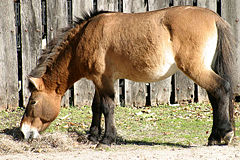 | ||||||||||||||||||
|
Endangered (ZSL 2006)
| ||||||||||||||||||
| Scientific classification | ||||||||||||||||||
| ||||||||||||||||||
| Equus ferus przewalskii (Poliakov, 1881) | ||||||||||||||||||
 Range map
|
Przewalski's horse is a rare, wild horse of Asia, Equus ferus przewalskii, characterized by a stocky built, a dark brown mane and tail, pale brown or dun-colored flanks, and often faintly striped legs. This large ungulate mammal is the last remaining wild horse (Equus ferus), although some classify it as another species, Equus przewalskii, or as a domestic horse subspecies, Equus caballus przewalskii. Przewalski's horse is the closest living wild relative of the domestic horse (Equus caballus), and it and the domestic horse are the only equids (genus Equus or family Equidae) that can crossbreed and produce fertile offspring, although they have different numbers of chromosomes. Przewalski's horse also is known as the Asian wild horse, Mongolian wild horse, or takhi.
Most "wild" horses today, such as the American mustang or the Australian brumby, are actually feral animals, horses that were once domesticated but escaped and reverted to an apparently wild status. Przewalski's horse, on the other hand, has never been successfully domesticated and remains a truly wild animal today. The tarpan, Equus ferus ferus, was also a wild horse, but became extinct in the early twentieth century.
At one point, Przewalski's horse was extinct in the wild, but in the 1990s was reintroduced into the Mongolian steppe from zoos and is now considered endangered in the wild. As a result of its preservation and reintroduction, this unique animal will be able to be appreciated and studied by future generations.
Overview and description
Overview
Przewalski's horse is one of ten living members of the Equus genus, a taxon that also includes domestic horses, zebras, donkeys, and onagers. All of the living members of the Equidae family are in the Equus genus. Extant equids are medium to large ungulate mammals, with long heads, and necks with a mane. Their legs are slender and end in a single, unguligrade toe, protected by a horny hoof. They have long, slender, tails, either ending in a tuft, or entirely covered in flowing hair. The pinnae ("ears") of equids are mobile, enabling them to easily localize the origin of sounds. They have two-color, or dichromatic vision. Their eyes are set back far on the head, giving them a wide angle of view, without entirely losing binocular vision. Equids also have a vomeronasal organ, that allows males to use the flehmen, or "lip-curling" response to assess the sexual state of potential mates.
Equids are herbivores, and feed predominantly on tough, fibrous food, such as grasses and sedges. When in need, they will also eat other vegetable matter, such as leaves, fruits, or bark, but are normally grazers, not browsers. Unlike ruminants, with their complex stomachs, equids break down cellulose in the "hindgut" or cecum, a part of the colon.
Przewalski's horse
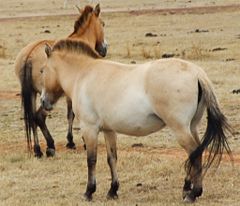
Przewalski's horse is placed into the same subgenus, Equus, as the domestic horse (Equus caballus), the wild horse (Equus ferus), the tarpan (Equus ferus ferus, a subspecies of the wild horse), and the Yukon horse (Equus lambei). The taxonomy of the Przewalski's horse, however, remains debated. Poliakov concluded that the animal was a wild horse species and gave it the official name Equus przewalskii (Poliakov 1881). Some consider it the last remnant of the wild horse, Equus ferus, and list it as the subspecies Equus ferus przewalskii. Others hold it as a subspecies of Equus caballus (domestic horse) as Equus caballus przewalskii).
Although Przewalski's horse has 66 chromosomes, compared to 64 in a domestic horse, the Przewalski's horse and the domestic horse are the only equids that crossbreed and produce fertile offspring, with the offspring possessing 65 chromosomes (Bell 2004). Normally, the offspring of a domestic horse and another equid, such as a zebra or a donkey, are sterile. However, the offspring of Przewalski horses and domestic horses are not sterile and subsequent crossings can lead back to either species. Bell (2004) notes that "if the offspring is crossed back to a domestic horse, the resulting animal will have 64 chromosomes and very few Przewalski characteristics."
Przewalski's horse is stockily built in comparison to domesticated horses, with shorter legs. It has a large head. Typical height is about 13 hands (1.32 meters), length is about 2.1 meters with a 90 centimeter tail. They weigh between 550 and 750 pounds (250 to 340 kilograms). The coat ranges from brown to the dun coloration (sandy yellow to reddish-brown) of domestic horses. It is dark brown around the mane (which stands erect) and yellowish-white on the belly. There is a dark stripe down the middle of the back and the legs are often faintly striped (NZP).
Behavior
In the wild, Przewalski's horses live in social groups consisting of a dominant stallion, a dominant lead mare, other mares, and their offspring. The patterns of their daily lives exhibit horse behavior similar to that of feral horse herds: Each group has a well-defined home range; within the range, the herd travels between three and six miles a day, spending time grazing, drinking, using salt licks, and dozing. At night, the herd clusters and sleeps for about four hours. Ranges of different herds may overlap without conflict, as the stallions are more protective of their mares than their territory.
Stallions practice a form of scent marking and will establish piles of dung at intervals along routes they normally travel to warn other males of their presence. In addition, when a female in the herd urinates, the stallion will frequently urinate in the same place, to signal her membership in the herd to other males. The stallions can frequently be seen sniffing dung piles to confirm scent markings (King and Gurnell 2006).
History
In the fifteenth century, Johann Schiltberger recorded one of the first European sightings of the horses in the journal of his trip to Mongolia as a prisoner of the Mongol Khan (DAS 1998). The horse is named after Russian General Nikolai Przhevalsky (1839–1888) (the spelling of the horse breed as "Przewalski" derives from the Polish spelling of the name). He was an explorer and naturalist who described the horse in 1881, after having gone on an expedition to find it, based on rumors of its existence. Many of these horses were captured around 1900 by Carl Hagenbeck and placed in zoos.
The native population declined in the 20th century due to a combination of factors, with the wild population in Mongolia dying out in the 1960s. The last herd was sighted in 1967 and the last individual horse in 1969. Expeditions after this failed to locate any horses, and the species was designated "extinct in the wild" for over 30 years.
After 1945, only two captive populations in zoos remained: in Munich and in Prague Zoo. The most valuable group in Askania Nova reserve in the Ukraine was shot down by German soldiers during occupation and the group in the United States had died.
In 1977, the Foundation for the Preservation and Protection of the Przewalski Horse was founded by Jan and Inge Bouman, which started a program of exchange between captive populations in zoos throughout the world to reduce inbreeding, and later starting a breeding program of its own.
In 1992, a cooperative venture between the Zoological Society of London and Mongolian scientists resulted in successful reintroduction of these horses from zoos into their natural habitat in Mongolia. Sixteen horses first were released into the wild in Mongolia, followed by additional animals later on. These reintroduced horses successfully reproduced and the status of the animal was considered to have changed from "extinct in the wild" to "endangered" in 2005 (ZSL 2006). However, they are classified as "extinct in the wild" by the IUCN Red List, as they have not been reassessed since 1996 (ESG 1996). The area to which they were reintroduced became Khustain Nuruu National Park in 1998.
Population size and reservation efforts
As of a census taken in 2005, the world population of Przewalski's horses was about 1,500, all descended from 31 horses that were in captivity in 1945, mostly descended from approximately 15 captured around 1900. As of 2005, there is a free-ranging population of 248 animals in the wild (ZSL 2006).
While dozens of zoos worldwide have Przewalski's Horses in small numbers, there are also specialized reserves dedicated primarily to the species.
The world's largest captive breeding program for Przewalski's horses is at the Askania Nova preserve in Ukraine. Several dozen Przewalski's horses were also released in the area evacuated after the Chernobyl accident, which now serves as a deserted de facto natural preserve (Mulvey 2006). An intensely researched population of free-ranging animals was introduced to the Hortobágy puszta in Hungary; data on social structure, behavior, and diseases gathered from these animals is used to improve the Mongolian conservation effort.
Three animals from this program live in a 12 acre (5 hectare) paddock in the Clocaenog Forest in North Wales, UK, on the site of a former Neolithic or Iron Age settlement. They were introduced there in 2004. The Forestry Commission hopes they will help recreate scenes from the Iron Age when horses similar to these roamed Britain freely, with Przewalski's horse believed to have roamed Britain three to 4,000 years ago, as evidenced from cave paintings (FC 2004).
Another herd exists at The Wilds Wildlife Preserve in Cumberland, Ohio, USA. The small herd of about 17 individuals is kept in a large area shared with other Asian animals. A small population is also kept by the Smithsonian Institution at a facility near Front Royal, Virginia and in the Smithsonian National Zoological Park in Washington, DC.
Recent advances in equine reproductive science have potential to further preserve and expand the gene pool. In October, 2007 scientists at the Smithsonian Institution's National Zoo successfully reversed a vasectomy on a Przewalski horse—the first operation of its kind on this species and possibly the first ever on any endangered species. While normally a vasectomy may be performed on an endangered animal under limited circumstances, particularly if an individual has already produced many offspring and its genes are overrepresented in the population, scientists realized the animal in question was one of the most genetically valuable Przewalski horses in the North American breeding program (AP 2008).
ReferencesISBN links support NWE through referral fees
- Associated Press (AP). 2008. Zoo performs first reverse vasectomy on horse. The Horse June 17, 2008 (article # 12095). Retrieved August 17, 2008.
- Bell, B. 2004. Featured equine: The Przewalski horse. EquinePost.com. Retrieved August 17, 2008.
- Department of Animal Science (DAS), Oklahoma State University. 1998. Breeds of livestock: Przewalski (sha-val-ski). Oklahoma State University. Retrieved August 17, 2008.
- Equid Specialist Group (ESG). 1996. Equus ferus ssp. przewalskii. 2007 IUCN Red List of Threatened Species. Retrieved August 17, 2008.
- Forestry Commission (FC). 2004. FC Wales turns clock back thousands of years with "wild" solution to looking after ancient forest site. Forestry Commission, Great Britain New Release 7001, September 16, 2004.
- International Commission on Zoological Nomenclature (ICZN). 2003. Opinion 2027 (Case 3010). Usage of 17 specific names based on wild species which are pre-dated by or contemporary with those based on domestic animals (Lepidoptera, Osteichthyes, Mammalia): Conserved. Bull.Zool.Nomencl. 60: 81-84.
- Ishida, N., T. Oyunsuren, S. Mashima, et al. 1995. Mitochondrial DNA sequences of various species of the genus Equus with special reference to the phylogenetic relationship between Przewalskii's wild horse and domestic horse. Journal of Molecular Evolution 41(2): 180–188. Retrieved August 17, 2008.
- Jansen, T., P. Forster, M. A. Levine, et al. 2002. Mitochondrial DNA and the origins of the domestic horse. PNAS 99(16): 10905–10910. PMID 12130666. Retrieved August 17, 2008.
- King, S. R. B., and J. Gurnell. 2006. Scent-marking behavior by stallions: An assessment of function in a reintroduced population of Przewalski horses, (Equus ferus przewalskii). Journal of Zoology 272(1): 30–36. Retrieved August 17, 2008.
- Mulvey, S. 2006. Wildlife defies Chernobyl radiation. BBC News April 20, 2006. Retrieved August 17, 2008.
- National Zoological Park (NZP). n.d. Przewalski's Horse, Equus ferus przewalskii. National Zoological Park. Retrieved August 17, 2008.
- Wakefield, S., J. Knowles, W. Zimmermann, and M. Van Dierendonck. 2002. Status and action plan for the Przewalski's Horse (Equus ferus przewalski). Page 82-92 in P. D. Moehlman, ed., Equids: Zebras, Asses and Horses. Status Survey and Conservation Action Plan. IUCN/SSC Equid Specialist Group. Gland, Switzerland and Cambridge, UK: IUCN.
- Wilford, J. N. 2005. Foal by foal, the wildest of horses is coming back. New York Times October 11, 2005. Retrieved August 17, 2008.
- Zoological Society of London (ZSL). 2006. Worlds last wild horse returns from the brink. Zoological Society of London.
Credits
New World Encyclopedia writers and editors rewrote and completed the Wikipedia article in accordance with New World Encyclopedia standards. This article abides by terms of the Creative Commons CC-by-sa 3.0 License (CC-by-sa), which may be used and disseminated with proper attribution. Credit is due under the terms of this license that can reference both the New World Encyclopedia contributors and the selfless volunteer contributors of the Wikimedia Foundation. To cite this article click here for a list of acceptable citing formats.The history of earlier contributions by wikipedians is accessible to researchers here:
The history of this article since it was imported to New World Encyclopedia:
Note: Some restrictions may apply to use of individual images which are separately licensed.
